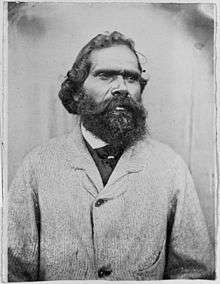Simon Wonga
| Simon Wonga | |
|---|---|
 Portrait by Carl Walter, 1866 | |
| Born | c. 1824 |
| Died | 1874 |
Simon Wonga (1824–1874), ngurungaeta and son of Billibellary, was an elder of the Wurundjeri indigenous people who lived in the Melbourne area of Australia. He was resolute that his people would survive the 'onslaught' of white men.
In 1835, he was present when his father and other Wurundjeri elders met with John Batman and witnessed the signing of the historically contentious 'treaty' which heralded the establishment of a permanent British colony in Victoria.[1]
William Barak was his cousin.
In 1840 Simon Wonga injured his foot in the Dandenongs. Billibellary searched for him, and when found carried him to a homestead where he was transported back to Melbourne by dray to be cared for and have his wound dressed for a period of two months by Assistant Protector William Thomas and wife Susannah.[2]
His father died in 1846 and by 1851 he was recgonised leader ngurungaeta or headman of the Wurundjeri and Kulin Nation people. [3]
By 1848 he had joined the Native Police Corp and led armed and mounted units conducting license hunts with Captain Dana during the early years of Victoria's gold rush. After the Corps were disbanded in 1853, he worked with Colonel Joseph Anderson, Joseph Panton, Alfred Selwyn, Robert Brough Smyth and as an occasional guide for landscape painters Eugene Von Guerard, Nicholas Chevalier and later with Louis Buvelot. He was a regular guest of Lilly and Paul de Castella at Yering Station while his family took refuge upstream on the Yarra River around Woori Yallock-Launching Place. A reserve was gazetted for that site until a gold rush to Hoddles Creek in1858.
In February 1859 some Wurundjeri elders, led by Simon Wonga (aged 35) and brother Tommy Munnering (aged 24) petitioned Protector William Thomas to secure land for the Taungurong at the junction of the Acheron and Goulburn rivers.
- "I bring my friends Goulburn Blacks, they want a block of land in their country where they may sit down plant corn potatoes etc etc, and work like white man." he told Thomas[3]
Initial representations to the Victorian Government were positive, however the intervention of the most powerful squatter in Victoria, Hugh Glass, resulted in their removal to a colder site, Mohican Station, which was not suitable for agricultural land and had to be abandoned. Finally in March 1863 the Kulin suggested a traditional camping site located at Coranderrk, near Healesville and requested ownership of this land. This meeting occurred at the State Exhibition buildings during celebrations for the marriage of the Prince of Wales and was sketched by Nicholas Chevalier and published in national newspapers. Access to the land was provided, though importantly not granted as freehold.[4][5]
He was a successful entrepreneur, described by Fred Cahir in 'Black Gold' (2013) as providing building materials, baskets and meats.
He was married three times, and none of his children survived. .[6]. Cause of Wonga's death is usually accepted as tuberculosis while some oral histories propose he was poisoned after conflict with chief medical officer Dr Wm McCrea, who devised dying out theories and with then Secretary later Director of Mining as well as Secretary of the Board of Protection for Aborigines Robert Brough Smyth.
The Melbourne suburb of Wonga Park and Wonga Road are named after him. He provided the name Donna Buang to Joseph Panton for a mountain in the upper Yarra and Wonga Road in Millgrove was named in his honor.
References
- ↑ http://www.dpc.vic.gov.au/index.php/aboriginal-affairs/projects-and-programs/leadership/victorian-aboriginal-honour-roll/victorian-aboriginal-honour-roll-2014-inductees/simon-wonga-1821-1874
- ↑ Isabel Ellender and Peter Christiansen, pp32-33 People of the Merri Merri. The Wurundjeri in Colonial Days, Merri Creek Management Committee, 2001 ISBN 0-9577728-0-7
- 1 2 State Library of Victoria, Simon Wonga, Accessed November 4, 2008
- ↑ Isabel Ellender and Peter Christiansen, pp112 People of the Merri Merri. The Wurundjeri in Colonial Days, Merri Creek Management Committee, 2001 ISBN 0-9577728-0-7
- ↑ Richard Broome, pp123-125, Aboriginal Victorians: A History Since 1800, Allen & Unwin, 2005, ISBN 1-74114-569-4, ISBN 978-1-74114-569-4
- ↑ "SIMON". The Australian News For Home Readers (90). Victoria, Australia. 25 August 1865. p. 13. Retrieved 26 May 2016 – via National Library of Australia.